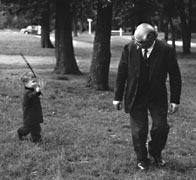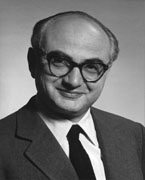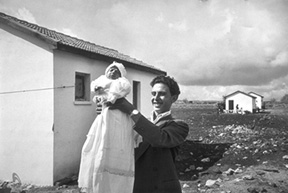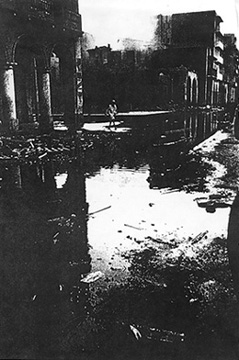
David Seymour (Chim).
Photograph by Elliott Erwitt
�1996 Elliott Erwitt

David Seymour (Chim).
Photograph by Philippe Halsman
�1996 from the Estate of Philippe Halsman

(Nazario) Eliezer Tritto and his daughter Myriam, Alma, Israel, 1951. Myriam was the first child to be born in the Italian immigrant settlement in Alma.
�1996 from the Estate of David Seymour

Nahal Kibbutz in the Huleh Valley. Israel, 1952
�1996 from the Estate of David Seymour

Patrolling the border between the Negev Desert in Israel on the border of Jordan. Israel, 1952
�1996 from the Estate of David Seymour

Port Said, Egypt, 1956
�1996 from the Estate of David Seymour

A woman mourns at the funeral of an Israeli watchman slain during a border incident at Beth Hafafa, Jerusalem, 1953.
�1996 from the Estate of David Seymour
|
The plight of the Jews was never far from Chim's consciousness, even,
as Cartier-Bresson described it, "with a certain sense of despair at his
own situation." However sophisticated and caring he was, however
much he enjoyed life, he was conditioned by the circumstances of his
background and by the fate of his parents in a world where anti-
Semitism was rife. The safe haven of Palestine, later Israel, for those
who had survived the Holocaust, was therefore never far from his
thoughts. In November 1947, the young United Nations passed a
resolution to partition Palestine into two new states, the State of
Israel and the State of Palestine. The latter was never formed
because the leaders of Egypt, Transjordan, Syria, Iraq, and Lebanon
rejected the partition, and immediately upon the formation of the
State of Israel, in May 1948, these five Arab nations attacked it in
war.
But it was not until October 1951, when Israel had been an
independent state for almost three years, that Chim arrived there,
having obtained from his sister all the addresses of their family in
Israel. "It will be strange to meet them after so many years!" he wrote,
and once there, "You can imagine how everything here is emotionally
charged and moving."
In those pioneering days, Israel was vibrant with the intimacy
of youth. During one of his trips, in December 1953, the newspapers
reported a not-infrequent incident: an Israeli soldier guarding some
Arab women picking olives near the border had been killed. In
heartrending photographs, Chim told the story of the funeral, and the
anguish at the sudden death of such a young man.
Chim returned to Israel almost every year until his untimely
death in 1956. As his coverage grew, it developed into a survey of the
important aspects of the young country's development: he did stories
on the all-important themes of defense of Israel's borders,
deployment of the water resources essential for irrigation, life in a
kibbutz, the development of the copper mines in the south that date back to
King Solomon's times, the oil pipeline, and other aspects of the
country's industrialization. And as time progressed, he photographed
Israel's important tourist sites. Had he lived, he would have continued
his coverage in Israel. As it is, there is enough material in Chim's
work for a book on the country's beginnings, idealistic and
enthusiastic as they were. In a way, the spirit of Chim's coverage in
Israel is reminiscent of his work during the Spanish civil war. In
those early years in Israel, there was the camaraderie,
purposefulness, and intimacy in the face of danger that he had
encountered in Spain. But there was more: he photographed the
stages of life, birth, marriage, and death. Looking at these
photographs, one cannot help feeling that Chim's soul rested in Israel,
the land of his forefathers.
Nineteen fifty-six was a busy and successful year. Chim went to
England to photograph an atomic energy installation there. He
covered the Italian elections. He once again photographed Ingrid
Bergman, his favorite subject, and other beautiful women. He
cemented new relationships with magazines: Newsweek and House
and Garden. For the latter he wrote his first text piece, scholarly and
amusing, on "The Legends of Rome." He wrestled down an
administrative monster to create an appropriate growth for Magnum,
and called the annual meeting for November 10 at which changes
would be explained and implemented.
He was in the Greek countryside enjoying a well earned vacation
when the Suez Canal crisis began, and at the same time, the
Hungarian revolution. Chim postponed the Magnum meeting for
coverage of these important events. Erich Lessing left Vienna for
Budapest. Burt Glinn was in Tel Aviv.
Chim knew it would be foolish for him to cover the Hungarian
revolution. Chim was almost forty-six years old, and he had not been
to war for twenty years. Chim thought it would be wonderful to
travel from Egypt to Israel, as the children of Israel did with Moses.
The Israeli forces advanced swiftly through the Negev onto
Egyptian soil. In Athens the press corps was excited by the news, and
frustrated trying to get to Egypt. Chim managed to obtain
transportation to Cyprus. While awaiting accreditation, he
photographed French paratroopers getting ready to fly off. There was
a day of waiting, which Chim spent reading dispatches, and also
photographing part of one of the religious festivals he loved so much.
There is a contact sheet of little girls in a procession, dressed up as
nuns and angels. The next day, Chim flew with Ben Bradlee of
Newsweek and Frank White of Time-Life to Port Said in Egypt. They
were joined by Paris Match photographer Jean Roy, known for his
war-time exploits. For the next day and a half they all drove through
the streets of Port Said. Frank White wrote:
Dave [Seymour] must have known what he was letting himself in
for. Ben Bradlee and I made no secret of the fact that we were
scared to death. But Dave, the quiet rational man, the
intellectual...said nothing. He just kept on making pictures. When
making pictures he seemed to be an entirely different man. He kept
saying, "this is a great story." I got the impression that he felt this
made him somehow impervious to risk.
On November 10, four days after the armistice, with Jean Roy
driving their jeep, Chim set out to photograph an exchange of
wounded soldiers at El Quantara. The photographers drove fast past
the Anglo-French lines and down the causeway toward the Egyptian
lines. Machine-gun bullets struck Jean Roy and Chim. The jeep turned
over. Both were dead.
Chim's body was flown back to New York. Over three hundred
people attended the memorial service for him. From Paris, Henri
Cartier-Bresson and Ernst Haas sent handwritten messages. Thinking
of Bob Capa and Werner Bischof, Ernst wrote: "Chim! As I don't
believe that death is an end, I can only say that I envy you the
company you will be in." And Henri: "Chim was a friend of mine since
24 years. I would like to just ask for a moment of silence to
meditate, as silence reaches beyond distance."
Inherent in their appreciation of the man is respect for the
quality of his photographs, for in a group bonded by the quality of
work, one is not possible without the other.
Chim styled himself a craftsman, and he had an unusual mastery
over his tools. He was devoted to the quest and sharing of
knowledge, with expert composition as the corollary in conveying this
knowledge. He was endowed with a tremendous tenderness and
great emotion. The photographs of his "Children" stand out as
haunting images, but as he progressed in age, his compositions
became more complex and more visual, a trifle less emotional. His late
work is full of his finest images. In his last years, he allowed himself
on occasion to indulge in purely visual problems, as in his outstanding
photographs involving sculpture.
There was in Chim a schism between the solid citizen who
enjoyed and recorded a variety of the concerns and pleasures of
civilized society and the artist. Witness to this dichotomy are the
splendid, original compositions and the phenomenon of the sudden,
always perfectly composed single exposures of a subject that are not
the work of a journalist, even if their content is journalistic.
In Chim there was that irrational element that is an important
part of creativity, which makes the artist in the performance of his
work feel free, and in this freedom, feel invulnerable. It is that
element on which journalist Frank White commented about Chim
photographing at Suez, just before his death, as he said, "When
making pictures he seemed to be an entirely different man ... I got
the impression that he felt this made him somehow impervious to the
risk..."
But for the lure of the story, Chim would have lived, as indeed he
had begun to live, to reconcile the brilliant aspects of his photography
with his equally brilliant ability to conduct a business whose capital
was the unruly, querulous spirit of ever-pioneering humanistic
photography.
As for the history of photography, this book is but an
introduction to Chim's work. Much more sifting, much more studying
will have to be done before we can codify David Seymour's repeated
patterns of composition and story structure, and his color work, about
which we have said nothing here. Only then will his influence on
photography be widely felt.
For now we may safely say that the scholar and humanist David
Seymour was a Renaissance man of impeccable ethics, blessed with
kindness, tolerance, modesty, and exquisite sensitivity in his
appreciation of others, of the world, and of the requirements of his
craft. Though he photographed for only fifteen years, his is an oeuvre
of distinction in the annals of modern photography.
- Inge Bondi
� 1996, Inge Bondi
from CHIM: The Photographs of David Seymour, Bulfinch Press/Little, Brown and Company
|





































